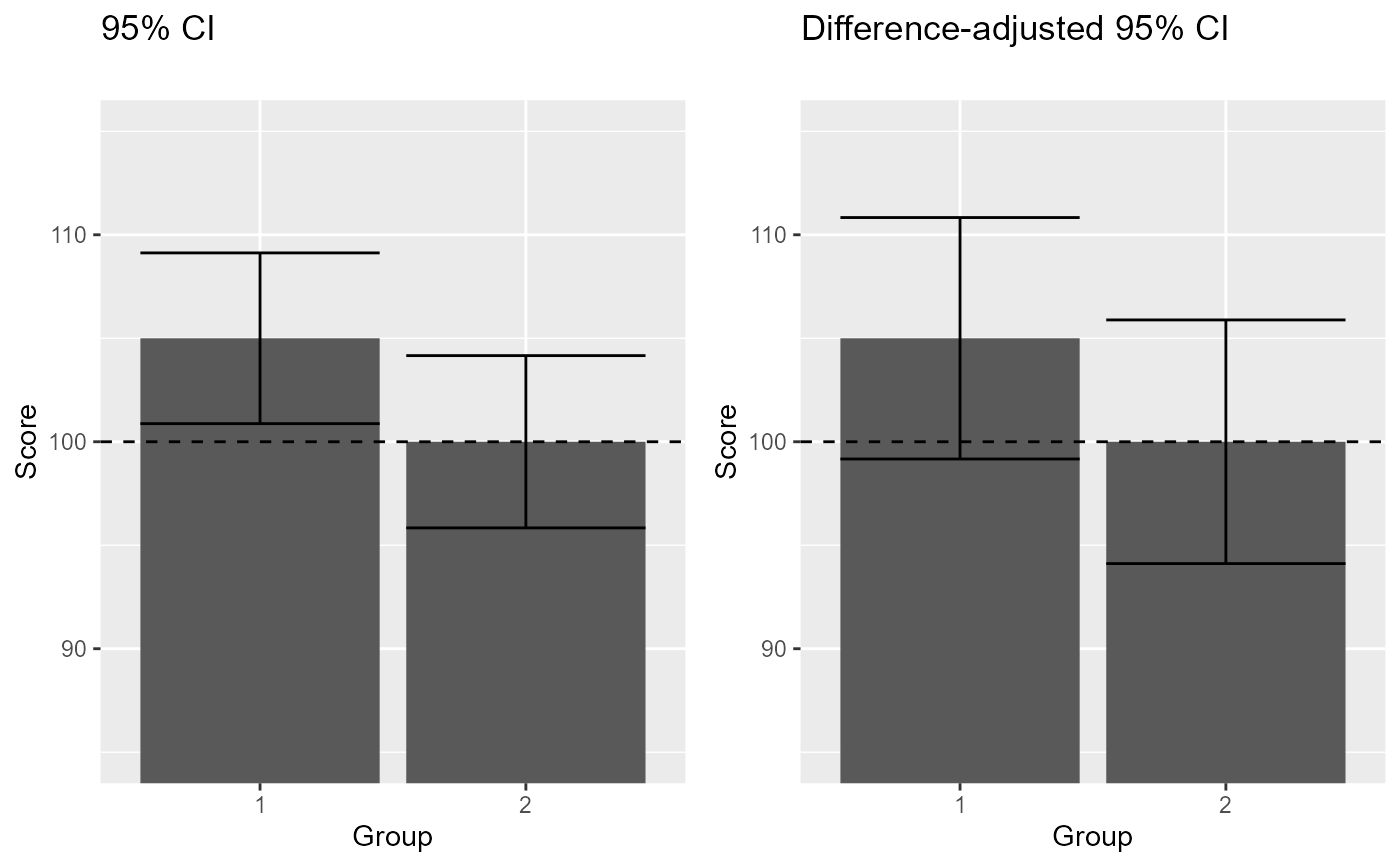The data, taken from (Cousineau 2017) , is an example where the "stand-alone" 95\% confidence interval of the means returns a result in contradiction with the result of a statistical test. The paradoxical result is resolved by using adjusted confidence intervals, here the different-adjusted confidence interval.
data(dataFigure1)Format
An object of class data.frame.
Source
References
Cousineau D (2017). “Varieties of confidence intervals.” Advances in Cognitive Psychology, 13, 140 – 155. doi:10.5709/acp-0214-z .
Examples
library(ggplot2)
library(gridExtra)
data(dataFigure1)
options(superb.feedback = 'none') # shut down 'warnings' and 'design' interpretation messages
## realize the plot with unadjusted (left) and ajusted (right) 95% confidence intervals
plt1a <- superb(
score ~ grp,
dataFigure1,
adjustments=list(purpose = "single"),
plotLayout="bar" ) +
xlab("Group") + ylab("Score") + labs(title="95% CI\n") +
coord_cartesian( ylim = c(85,120) ) +
geom_hline(yintercept = 100, colour = "black", linewidth = 0.5, linetype=2) +
showSignificance( c(0.5, 2.5), 115, -1, "significant???",
segmentParams = list( colour = "red" ) )
plt1b <- superb(
score ~ grp,
dataFigure1,
adjustments=list(purpose = "difference"),
plotLayout="bar" ) +
xlab("Group") + ylab("Score") + labs(title="Difference-adjusted 95% CI\n") +
coord_cartesian( ylim = c(85,120) ) +
geom_hline(yintercept = 100, colour = "black", linewidth = 0.5, linetype=2)+
showSignificance( c(0.5, 2.5), 115, -1, "Not significant!",
segmentParams = list( colour = "chartreuse3" ) )
plt1 <- grid.arrange(plt1a,plt1b,ncol=2)
 ## realise the correct t-test to see the discrepancy
t.test(dataFigure1$score[dataFigure1$grp==1],
dataFigure1$score[dataFigure1$grp==2],
var.equal=TRUE)
#>
#> Two Sample t-test
#>
#> data: dataFigure1$score[dataFigure1$grp == 1] and dataFigure1$score[dataFigure1$grp == 2]
#> t = 1.7612, df = 48, p-value = 0.08458
#> alternative hypothesis: true difference in means is not equal to 0
#> 95 percent confidence interval:
#> -0.7082201 10.7082201
#> sample estimates:
#> mean of x mean of y
#> 105 100
#>
## realise the correct t-test to see the discrepancy
t.test(dataFigure1$score[dataFigure1$grp==1],
dataFigure1$score[dataFigure1$grp==2],
var.equal=TRUE)
#>
#> Two Sample t-test
#>
#> data: dataFigure1$score[dataFigure1$grp == 1] and dataFigure1$score[dataFigure1$grp == 2]
#> t = 1.7612, df = 48, p-value = 0.08458
#> alternative hypothesis: true difference in means is not equal to 0
#> 95 percent confidence interval:
#> -0.7082201 10.7082201
#> sample estimates:
#> mean of x mean of y
#> 105 100
#>